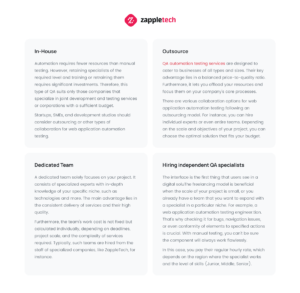The QA industry is gaining popularity because it offers many opportunities for those who order and deliver software development. The same goes for web application automation web testing tools, which improves the QA process.

- According to GM Insights, the value of the automation market exceeded $20 billion in 2022. According to the same source, the segment will grow at a CAGR of 15% by 2023 and reach more than $80 billion.
ZappleTech specialists have prepared comprehensive material to help you better understand the essence and benefits of web application automation testing.
Table of Contents
Why Is Web Application Automation Testing Important?
According to the results of the industry analysis by Custom Market Insights, corporate and SME representatives wanted to automate about 75% of test cases for their software in 2021.
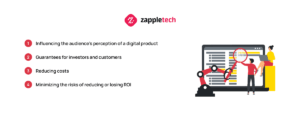
This shows that QA is now perceived as a catalyst for the viability of digital solutions and is rapidly gaining popularity. And for a good reason, because web application automation testing plays a vital role in preparing software for release and its further scaling.
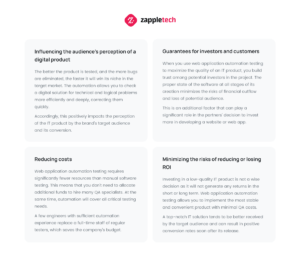
Influencing the audience’s perception of a digital product
The better the product is tested, and the more bugs are eliminated, the faster it will win its niche in the target market. The automation allows you to check a digital solution for technical and logical problems more efficiently and deeply, correcting them quickly.
Accordingly, this positively impacts the perception of the IT product by the brand’s target audience and its conversion.
Guarantees for investors and customers
When you use automated web application automation testing to maximize the quality of an IT product, you build trust among potential investors in the project. The proper state of the software at all stages of its creation minimizes the risks of financial outflow and loss of potential audience.
This is an additional factor that can play a significant role in the partners’ decision to invest more in developing a website or web app.
Reducing costs
Web application automation testing requires significantly fewer resources than manual software testing. This means that you don’t need to allocate additional funds to hire many QA specialists. At the same time, web test automation will cover all critical testing needs.
A few engineers with sufficient automation experience replace a full-time staff of regular testers, which saves the company’s budget.
Minimizing the risks of reducing or losing ROI
Investing in a low-quality IT product is not a wise decision as it will not generate any returns in the short or long term. Web application automation web testing tool allows you to implement the most stable and convenient product with minimal QA costs.
A top-notch IT solution tends to be better received by the target audience and can result in positive conversion rates soon after its release.
Market Trends of Web Application Automation Testing
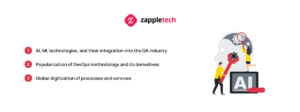
According to the GM Insights report, the critical catalysts for the development of the test automation market in the period 2022-2030 will be:
- AI, ML technologies, and their integration into the QA industry.
- Popularization of DevOps methodology and its derivatives.
- Global digitization of processes and services.
Accordingly, this will lead to new trends in the segment that will help transform traditional QA into a modernized format. We will discuss some of the main trends for the coming period below.
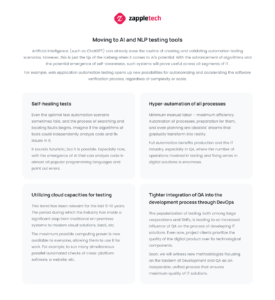
Hyper-automation of all processes
Minimum manual labor – maximum efficiency. Automation of processes, preparation for them, and even planning are idealists’ dreams that gradually transform into reality.
Full automation benefits production and the IT industry, especially in QA, where the number of operations involved in testing and fixing errors in digital solutions is enormous.
Self-healing tests
Even the optimal test automation scenario sometimes fails, and the process of searching and locating faults begins. Imagine if the algorithms of tools could independently analyze code and fix issues in it.
It sounds futuristic, but it is possible. Especially now, with the emergence of AI that can analyze code in almost all popular programming languages and point out errors.
Moving to AI and NLP testing tools
Artificial intelligence (such as ChatGPT) can already ease the routine of creating and validating automation testing scenarios. However, this is just the tip of the iceberg when it comes to AI’s potential. With the advancement of algorithms and the potential emergence of self-awareness, such systems will prove useful across all segments of IT.
For example, web application automation testing opens up new possibilities for autonomizing and accelerating the software verification process, regardless of complexity or scale.
Utilizing cloud capacities for testing
This trend has been relevant for the last 5-10 years. The period during which the industry has made a significant step from traditional on-premises operating systems, to modern cloud solutions, SaaS, etc.
The maximum possible computing power is now available to everyone, allowing them to use it for work. For example, to run many simultaneous parallel automated checks of cross-platform software, a website, etc.
Tighter integration of QA into the development process through DevOps
The popularization of testing, both among large corporations and SMEs, is leading to an increased influence of QA on the process of developing IT solutions. Even now, project clients prioritize the quality of the digital product over its technological components.
Soon, we will witness new methodologies focusing on the tandem of Development and QA as an inseparable, unified process that ensures maximum quality of IT solutions.
Benefits of Web Application Automated Testing
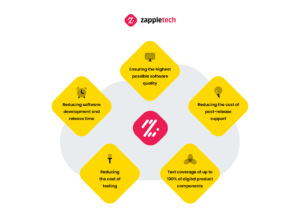
According to a research study conducted by Microfocus analysts, the main benefits of web application automation testing are revealed during the development stages (48% of respondents) and working with requirements (47% of respondents).
Based on this, we can conclude that the earlier testing automation is integrated into a project, the more benefits it brings to the team creating the IT solution and the client.
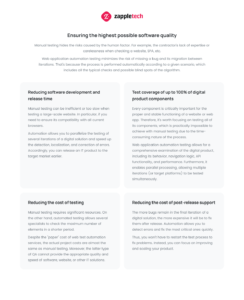
Ensuring the highest possible software quality
Manual testing hides the risks caused by the human factor. For example, the contractor’s lack of expertise or carelessness when checking a website, SPA, etc.
Web application automation testing minimizes the risk of missing a bug and its migration between iterations. That’s because the process is performed automatically according to a given scenario, which includes all the typical checks and possible blind spots of the algorithm.
Reducing software development and release time
Manual testing can be inefficient or too slow when testing a large-scale website. In particular, if you need to ensure your website testing its compatibility with all current browsers.
Automation allows you to parallelize the testing of several iterations of a digital solution and speed up the detection, localization, and correction of errors. Accordingly, you can release an IT product to the target market earlier.
Reducing the cost of post-release support
The more bugs remain in the final iteration of a digital solution, the more expensive it will be to fix them after release. Automation allows you to detect errors and fix the most critical ones quickly.
Thus, you won’t have to restart the test process to fix problems. Instead, you can focus on improving and scaling your product.
Reducing the cost of testing
Manual testing requires significant resources. On the other hand, an automated testing tool allows several specialists to check the maximum number of elements in a shorter period.
Despite the “paper” cost of web test automation services, the actual project costs are almost the same as manual web testing alone. Moreover, the latter type of QA cannot provide the appropriate quality and speed of software, website, or other IT solutions.
Test coverage of up to 100% of digital product components
Every component is critically important for the proper and stable functioning of a website or web app. Therefore, it’s worth focusing on testing all of its components, which is practically impossible to achieve with manual testing due to the time-consuming nature of the process.
Web application automation testing allows for a comprehensive examination of the digital product, including its behavior, navigation logic, API functionality, and performance. Furthermore, it enables parallel processing, allowing multiple iterations (or target platforms) to be tested simultaneously.
Levels of Such Testing Process
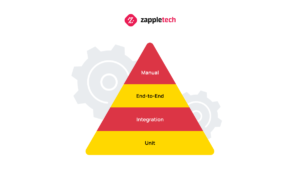
The process is divided into several levels to organize sequential and logically justified testing. Each level plays a critically important role in ensuring the final quality of the IT solution.
Traditionally, there are three main categories of tests: unit, integration, and end-to-end. However, there is a fourth type of test creation, present in all testing projects without exception: manual testing. Manual testing is used for control checks after error correction or to confirm the presence of an issue.
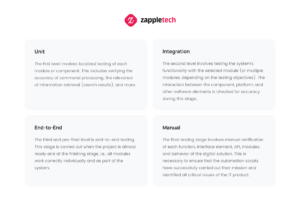
Unit
The first level api testing involves localized testing of each module or component. This includes verifying the accuracy of command processing, the relevance of information retrieval (search results), and more.
This stage sets the direction for further testing and establishes priorities, such as compatibility checks with specific elements and interaction with the rest of the system. Additionally, during this iteration, errors are most easily and quickly identified.
Integration
The second level involves testing the system’s functionality with the selected module (or multiple modules, depending on the testing objectives). The interaction between the component, platform, and other software elements is checked for accuracy during this stage.
If any issues arise, they are identified, and problematic areas are discovered through which the system functions incorrectly. Making corrections and conducting retesting does not impact the project deadline since this is an intermediate stage of development (the digital product is not fully deployed yet).
End-to-End
The third and pre-final level is end-to-end testing. This stage load testing is carried out when the project is almost ready and at the finishing stage, i.e., all modules work correctly individually and as part of the system.
The goal remains the same: to find and localize bugs, fix them, and prevent the risk of new issues.
Manual
The final testing stage involves manual verification of each function, interface element, API, modules, and behavior of the digital solution. This is necessary to ensure that the automation test scripts have successfully carried out their mission and identified all critical issues of the IT product.
In addition, manual testing is necessary for correctly building automation scenarios and fixing problems in the code or algorithm of cases.
This type of check is always carried out, regardless of test pass rate, the potential coverage of software elements, etc. We can consider this as a quality assurance checkpoint before the project is delivered to the customer.
What Web Application Testing Should Be Automated?
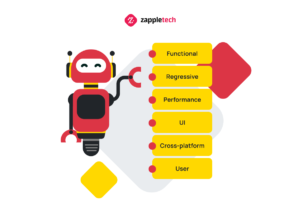
You can perform web application automation testing for all types of tests. However, it is not efficient and expensive, as it takes more time to create an algorithm test script than a manual test.
It is important to choose the types of testing you can and should automate to achieve the best test result in the shortest possible time.
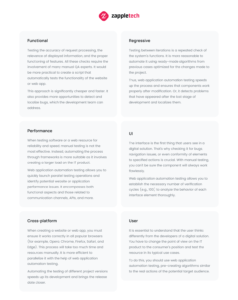
Functional
Testing the accuracy of request processing, the performance testing the relevance of displayed information, and the proper functioning of features. All these checks require the involvement of many manual QA experts. It would be more practical to create a script that automatically tests the functionality of the website or web app.
This approach is significantly cheaper and faster. It also provides more opportunities to detect and localize bugs, which the development team can address.
Regressive
Testing between iterations is a repeated check of the system’s functions called regression testing. It is more reasonable to automate it using ready-made algorithms from previous cases optimized for the changes made to the project.
Thus, web application automation testing speeds up the process and ensures that components work properly after modification. Or, it detects problems that have appeared after the last stage of development and localizes them.
Performance
When testing software or a web resource for reliability and speed, manual testing is not the most effective. Instead, automating the process through frameworks is more suitable as it involves creating a larger load on the IT product.
Web application automation testing allows you to quickly launch parallel testing operations and identify potential website or application performance issues. It encompasses both functional aspects and those related to communication channels, APIs, and more.
UI
The interface is the first thing that users see in a digital solution. That’s why checking it for bugs, navigation issues, or even conformity of elements to specified actions is crucial. With manual testing, you can’t be sure the component will always work flawlessly.
Web application automation testing allows you to establish the necessary number of verification cycles (e.g., 100) to analyze the behavior of each interface element thoroughly.
Cross-platform
When creating a website or web app, you must ensure it works correctly in all popular browsers (for example, Opera, Chrome, Firefox, Safari, and Edge). This process will take too much time and resources manually. It is more efficient to parallelize it with the help of web application automation testing tool.
Automating the testing of different project versions speeds up its development and brings the release date closer.
User
It is essential to understand that the user thinks differently from the developers of a digital solution. You have to change the point of view on the IT product to the consumer’s position and test the resource in its typical use cases.
To do this, you should use web application automation testing, pre-creating algorithms similar to the real actions of the potential target audience.
How to Implement the Process of Such Testing
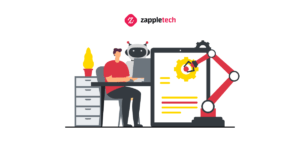
It’s not enough to decide that you will automate the testing process. You must also define how QA operations will occur, who will perform the tasks, and how to optimize them.
Let’s briefly go through the main models of QA services to determine the ideal one for your project and budget.
In-House
Automation requires fewer resources than manual testing. However, retaining specialists of the required level and training or retraining them requires significant investments. Therefore, this type of QA suits only those companies that specialize in joint development and automated testing tools and services or corporations with a sufficient budget.
Startups, SMEs, and development studios should consider outsourcing or other types of collaboration for web application automation testing.
Outsource
QA automation tools and testing services are designed to cater to businesses of all types and sizes. Their key advantage lies in a balanced price-to-quality ratio. Furthermore, it lets you offload your resources and focus them on your company’s core processes.
There are various collaboration options for web application automation testing following an outsourcing model. For instance, you can hire individual experts or even entire teams. Depending on the scale and objectives of your project, you can choose the optimal solution that fits your budget.
Dedicated Team
A dedicated team solely focuses on your project. It consists of specialized experts with in-depth knowledge of your specific niche, such as technologies and more. The main advantage lies in the consistent delivery of services and their high quality.
Furthermore, the team’s work cost is not fixed but calculated individually, depending on deadlines, project scale, and the complexity of services required. Typically, such teams are hired from the staff of specialized companies, like ZappleTech, for instance.
Hiring independent QA specialists
The freelancing model is beneficial when the scale of your project is small, or you already have a team that you want to expand with a specialist in a particular niche. For example, a web application automation testing engineer.
In this case, you pay their regular hourly rate, which depends on the region where the specialist works and the level of skills (Junior, Middle, Senior).
Tools for Web Automation Testing
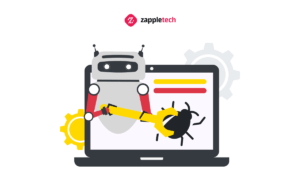
Various tools and frameworks are used for web application automation testing. Let’s look at the most effective ones and briefly consider their advantages.
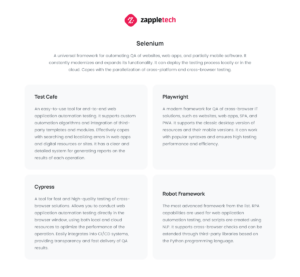
Selenium
A universal framework for automating QA of websites, web apps, and partially mobile software. It constantly modernizes and expands its functionality. It can deploy the testing process locally or in the cloud. Copes with the parallelization of cross-platform and cross-browser testing.
Test Cafe
An easy-to-use tool for end-to-end web application automation testing. It supports custom automation algorithms and integration of third-party templates and modules. Effectively copes with searching and localizing errors in web apps and digital resources or sites. It has a clear and detailed system for generating reports on the results of each operation.
Playwright
A modern framework for QA of cross-browser IT solutions, such as websites, web apps, SPA, and PWA. It supports the classic desktop version of resources and their mobile versions. It can work with popular syntaxes and ensures high testing performance and efficiency.
Cypress
A tool for fast and high-quality testing of web applications and cross-browser solutions. Allows you to conduct web application automation testing directly in the browser window, using both local and cloud resources to optimize the performance of the operation. Easily integrates into CI/CD systems, providing transparency and fast delivery of QA results.
Robot Framework
The most advanced framework from the list. RPA capabilities are used for web application automation testing, and scripts are created using NLP. It supports cross-browser checks and can be extended through third-party libraries based on the Python programming language.
Best Practices for Web Application Automation Testing
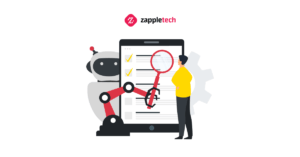
Choosing the tools and type of QA services is only the initial preparation stage for the actual process. You need to create a work schedule and a roadmap, considering potential delays in the process, and prioritize the checks.
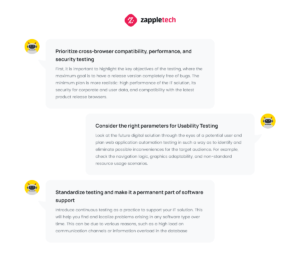
Prioritize cross-browser compatibility, performance, and security testing
First, it is important to highlight the key objectives of the testing, where the maximum goal is to have a release version completely free of bugs. The minimum plan is more realistic: high performance of the IT solution, its security for corporate and user data, and compatibility with the latest product release browsers.
Consider the right parameters for Usability Testing
Look at the future digital solution through the eyes of a potential user and plan web application automation testing in such a way as to identify and eliminate possible inconveniences for the target audience. For example, automated tests can check the navigation logic, graphics adaptability, and non-standard resource usage scenarios.
Standardize testing and make it a permanent part of software support
Introduce continuous testing as a practice to support your IT solution. This will help you find and localize problems arising in any software type over time. This can be due to various reasons, such as a high load on communication channels or information overload in the database.
How to Properly Organize the Process of Web Application Automation Testing
It is essential to ensure a high-quality workflow to maximize the interaction between the development and QA departments. You can do this by integrating modern tools and best practices.
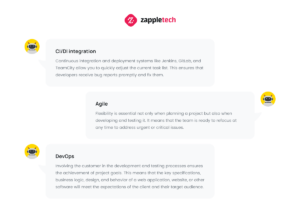
CI/DI integration
Continuous integration and deployment systems like Jenkins, GitLab, and TeamCity allow you to quickly adjust the current task list. This ensures that developers receive bug reports promptly and fix them.
Agile
Flexibility is essential not only when planning a project but also when developing and testing it. It means that the team is ready to refocus at any time to address urgent or critical issues.
DevOps
Involving the customer in the development and testing processes ensures the achievement of project goals. This means that the key specifications, business logic, design, and behavior of a web application, website, or other software will meet the expectations of the client and their target audience.
How to Organize a Team for Great Work in the Field of Web Application Automation Testing
Workflow organization becomes especially important when third-party specialists are involved in a project. For example, with an outsourcing model, when you cannot personally control the work of contractors. There are some common practices to improve interaction with them.
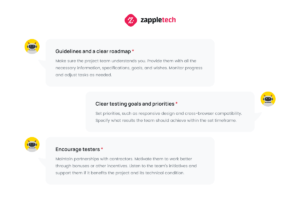
Guidelines and a clear roadmap
Make sure the project team understands you. Provide them with all the necessary information, specifications, goals, and wishes. Monitor progress and adjust tasks as needed.
Clear testing goals and priorities
Set priorities, such as responsive design and cross-browser compatibility. Specify what results the team should achieve within the set timeframe.
Encourage testers
Maintain partnerships with contractors. Motivate them to work better through bonuses or other incentives. Listen to the team’s initiatives and support them if it benefits the project and its technical condition.
Challenges and Solutions in Web Application Automation Testing
As with other workflows, there are certain challenges in QA, primarily related to the involvement of third-party specialists in the project. However, you can mitigate them by following these tips.
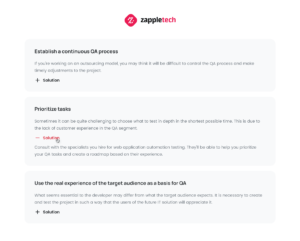
Establish a continuous QA process
If you’re working on an outsourcing model, you may think it will be difficult to control the QA process and make timely adjustments to the project.
- Solution
Use CI/CD tools and additional communication channels. Set the frequency of meetings and prepare checklists for the tasks of each stage.
Prioritize tasks
Sometimes it can be quite challenging to choose what to test in depth in the shortest possible time. This is due to the lack of customer experience in the QA segment.
- Solution
Consult with the specialists you hire for web application automation testing. They’ll be able to help you prioritize your QA tasks and create a roadmap based on their experience.
Use the real experience of the target audience as a basis for QA
What seems essential to the developer may differ from what the target audience expects. It is necessary to create and test the project in such a way that the users of the future IT solution will appreciate it.
- Solution
When hiring QA specialists, ask them to involve representatives of a typical target audience in the project. Based on their feedback, optimize the digital product to improve its chances of viability and success in the industry.
Why Zappletech Is the Ideal Choice for Web Application Automation Testing
If you’re concerned about your time and money but still want to carry out an efficient QA process for your future project, delegate this task to professionals.
ZappleTech experts have successfully performed a comprehensive range of operations to ensure maximum quality for digital products for over 12 years, regardless of their initial technical state.
Entrust the web application automation testing to ZappleTech experts and receive a competitive and robust IT solution with great potential!

